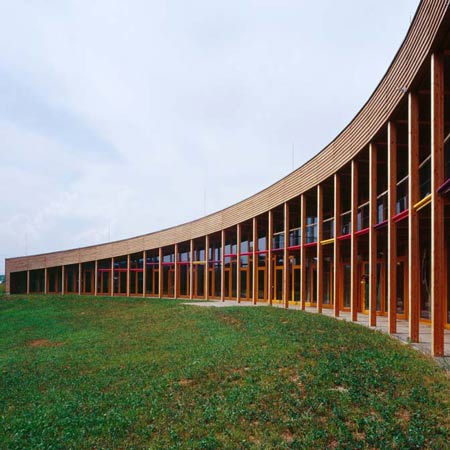Prague architects Projektil Architekti have completed Sluňákov, a centre for ecological activities in Olomouc, the Czech Republic.
The building aims to promote environmental awareness and contains an information centre and education facilities for school groups.
The building is charactised by a south-facing, curved glass facade with movable sun blinds and is designed to be heated and ventilated naturally.
Photographs by Andrea Lhotakova
Here is some more information from the architects:
--
Slunakov – Centre for Ecological Activities of the city of Olomouc was designed as a part of the project entitled “Slunakov, facilities for ecological activities – educational biocenter”, which is located northwest of Olomouc, in the Morava River valley. The facilities are to be used to educate the public about the environment and its processes and to support public environmental awareness. The building is also used as an information center and an entrance to the Nature Protection Area of Litovelske Pomoravi. The Center itself is used for a wide range of activities. The main aims are providing one-day and one-week environmental education programs for school-aged groups and professional seminars on ecology and education. The building also enables “soft tourism” that includes environmental education programs. Because the Center has been designed as an energy-saving building, it also provides the public with an example of the possibilities available when designing ecological housing and promoting sustainable development.
Architectural Design
The building was designed as a curved inhabitable land wave that fluently blends into the surrounding terrain and symmetrically follows the exact North-South axes. The architectural design utilizes the southern orientation with a southern glass facade with movable sun blinds. Two recessed entrances are situated on the northern side.
The eastern side of the building symbolically ascends from the ground to enhance the display of the southwestern sunshine. The earth-sheltered northern side of the building fluently adjoins the building’s earth-covered roof, which gradually increases in height from the west to the east. The path that leads the visitor from the main entrance over the “ridge” of the building goes on to the “top” lookout point that provides a unique view of the entire biocenter. The area between the building and the artificial mound in front of the southern facade is used as a living garden for guests and visitors.
The unusual style of the proposed building results from a process of looking for new forms of ecological buildings that not only integrate into the surrounding environment, but also utilize solar energy and are earth-sheltered to increase protection from unfavorable weather. The initial form proposed was inspired by the low-to-the-ground, rustic buildings traditionally found in the region of Hana. The shape of the solar eclipse served as inspiration for the curve of the building.
The building’s ground floor is raised to ensure that it is above flood level. Flexibility, which is perceived as beneficial to the ecological concept of the entire building, was stressed when solving the problem of room plan. The backbone of the building is the hallway that runs the entire length of the building. All rooms are accessible from the hallway. On the sunny southern side from the hallway there is a residential area, partially one floor (lecture hall, dining room, class rooms, offices), partially two floors (accommodation, caretaker’s flat) and on the shaded northern side there are appliances. Similarly, the building is divided into two different parts, from the point of view of the construction. The northern part was proposed to be built as a reinforced concrete skeleton construction, the southern part with the hallway and the load bearing structure made by wooden frames.
All materials used are traditional and have been chosen due to their environmental friendliness. The facades are covered by wood, glass, concrete and stone (stacked). The interior is completed using mainly wood, glass and brick walls plastered or, in the case of unburnt brick, left uncovered. Burnt brick or reinforced concrete is used in the supporting structure for the technical rooms and wet activity areas. Most floors are covered by wooden planks and those in wet activity areas or in technical areas are covered by seamless floor. The entire concept of the interior and exterior of the building is based on reality and takes into account the use of natural colors and surface structures of individual building materials.
Not only does the building have passive building elements (southern glass facade, earth shelter on the northern side) that enable the building to save on energy and help the environment, but it also has active measures. These measures, such as a heating and ventilation using heat recovery to heat the building, solar collectors for hot water preparation and for support of space heating and earth heat exchanger, are also used for educational and demonstration purposes.
Building-energy concept
The building-energy concept was designed with respect to the basic principles of sustainable development. The building is designed for a full year-long operation with the four-month-long heating season only. The heat demand is covered using a combination of renewable energy sources – biomass and solar energy. Ventilation and warm air heating are ensured by fresh air and by warm air circulation ventilation with heat recovery from outgoing air. The building is divided into six separate ventilated zones. Earth heat exchangers that serve mainly to bring cooler air inside in the summer months are located in the earthen berm behind the building. Two automatic wood pellet furnaces provide the main source of heat for heating and are a supplementary source for heating the hot water. A modern solar system that decreases the need for secondary energy for hot water heating has been proposed. It covers 70% of hot water demand and 20% of heating.
Above: ground floor
Above: first floor
Above: site plan
Above: sections

